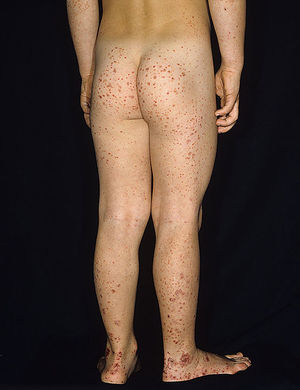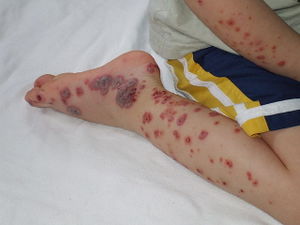We need you! Join our contributor community and become a WikEM editor through our open and transparent promotion process.
Henoch-Schonlein purpura
From WikEM
(Redirected from Henoch-schonlein purpura)
Contents
Background
- Abbreviation: HSP
- Classical triad of non-thrombocytopenic palpable purpura, abdominal pain, arthritis
- Most common vasculitis in childhood (usually 2-11 yr)
- More common in white/asian males
- Small vessel
- IgA mediated
- 5% of cases associated with intussusception (abdominal vasculitis)
- Most cases preceded by a URI
- 95% recover completely after 3-4wk
- Progression to renal insufficiency is feared complication (5-15% in children)[1]
- Presentation in adults is often worse, with persisting renal insufficiency in 30-50%
- Adults may require more aggressive treatment with steroids +/- cyclophosphamide though evidence of benefit is lacking
Clinical Features
Classic
Symptoms may develop over the course of days to weeks and vary in order of presentation
- Rash: palpable purpura
- Often begins with erythematous, macular, or urticarial wheals, progressing into the typical ecchymoses, petechiae, and palpable purpura (see picture)
- Typically appears in crops, symmetrically distributed, and located primarily in gravity/pressure-dependent areas (e.g. lower extremities, buttocks)
- Acute abdominal pain
- Typically diffuse and colicky
- May have blood in the stool (massive bleeding is rare)
- Arthritis/arthralgia
- Migratory, usually involves knees/ankles
- Glomerulonephritis/renal disease
- (~50% of the time)[2]
- Hematuria +/- proteinuria
Rare manifestations
- Melena, hematemesis, hepatosplenomegaly
- Headache, seizures
- Fever
- Non-pitting edema of the extremities and face
- Nephrotic syndrome
Differential Diagnosis
Pediatric Abdominal Pain
0–3 Months Old
- Emergent
- Nonemergent
3 mo–3 y old
- Emergent
- Nonemergent
3 y old–adolescence
- Emergent
- Nonemergent
- Constipation
- Acute Gastroenteritis
- Nonspecific viral syndrome
- Streptococcus pharyngitis
- Urinary Tract Infections
- Pneumonia
- Renal Stone
- Henoch-Schonlein purpura
- Inflammatory bowel disease
Petechiae/Purpura (by cause)
- Abnormal platelet count and/or coagulation
- Septicemia
- Idiopathic thrombocytopenic purpura (ITP)
- Hemolytic uremic syndrome
- Leukemia
- Coagulopathies (e.g. hemophilia)
- Henoch-Schonlein Purpura (HSP)
- Acute hemorrhagic edema of infancy (AHEI)
- Hypersensitivity vasculitis
- Primary vasculitides
- Wegener's
- Microscopic polyangiitis
- Eosinophilic granulomatosis with polyangiitis (Churg-Strauss syndrome)
- Secondary vasculitides
- Connective tissue disorder
- Scurvy
- Infectious disease
- Hepatitis B
- Hepatitis C
- Trauma
Causes of Glomerulonephritis
- Poststreptococcal glomerulonephritis
- Hemolytic-uremic syndrome
- Henoch-Schonlein purpura
- IgA nephropathy
- Lupus nephritis
- Alport syndrome
- Goodpasture syndrome
Evaluation
Work-Up
- CBC (increased WBC and PLT)
- CRP/ESR (increased)
- Chemistry
- PT/PTT (normal)
- Urinalysis (hematuria, proteinuria)
- Stool guaiac (positive in >50%)[5] — indicates GI vasculitis
- Consider abdominal ultrasound — increased risk of intussusception
Evaluation
- Usually a clinical diagnosis — rule out other causes
- No lab test is diagnostic
- Biopsy of affected organ (eg skin or kidney) with predominantly IgA deposition supports diagnosis
Management
- Supportive
- NSAIDs for pain, may worsen renal disease or GI disease
- Consider prednisone 1mg/kg/day for severe arthralgias, abdominal or scrotal disease
Disposition
- Outpatient management for most with rheumatology follow up
- Outpatient renal consult
- Recurrence rate of up to 33%
See Also
References
- ↑ Pillebout E et al. Henoch-Schönlein Purpura in Adults: Outcome and Prognostic Factors. JASN May 1, 2002 vol. 13 no. 5 1271-1278.
- ↑ Chen JY et al. Henoch-Schönlein purpura nephritis in children: incidence, pathogenesis and management. World J Pediatr. 2015 Feb;11(1):29-34. doi: 10.1007/s12519-014-0534-5. Epub 2014 Dec 29.
- ↑ Calviño, MC, Llorca, J, García-Porrúa, C, Fernández-Iglesias, JL, Rodriguez-Ledo, P, González-Gay, MA (2001) Henoch-Schönlein purpura in children from northwestern Spain: a 20-year epidemiologic and clinical study. Medicine (Baltimore) 80: pp. 279-290
- ↑ Saulsbury, FT (1999) Henoch-Schönlein purpura in children. Report of 100 patients and review of the literature. Medicine (Baltimore) 78: pp. 395-409
- ↑ Chang WL, Yang YH, Lin YT, Chiang BL. "Gastrointestinal manifestations in Henoch-Schönlein purpura: a review of 261 patients." Acta Paediatr. 2004;93(11):1427.



